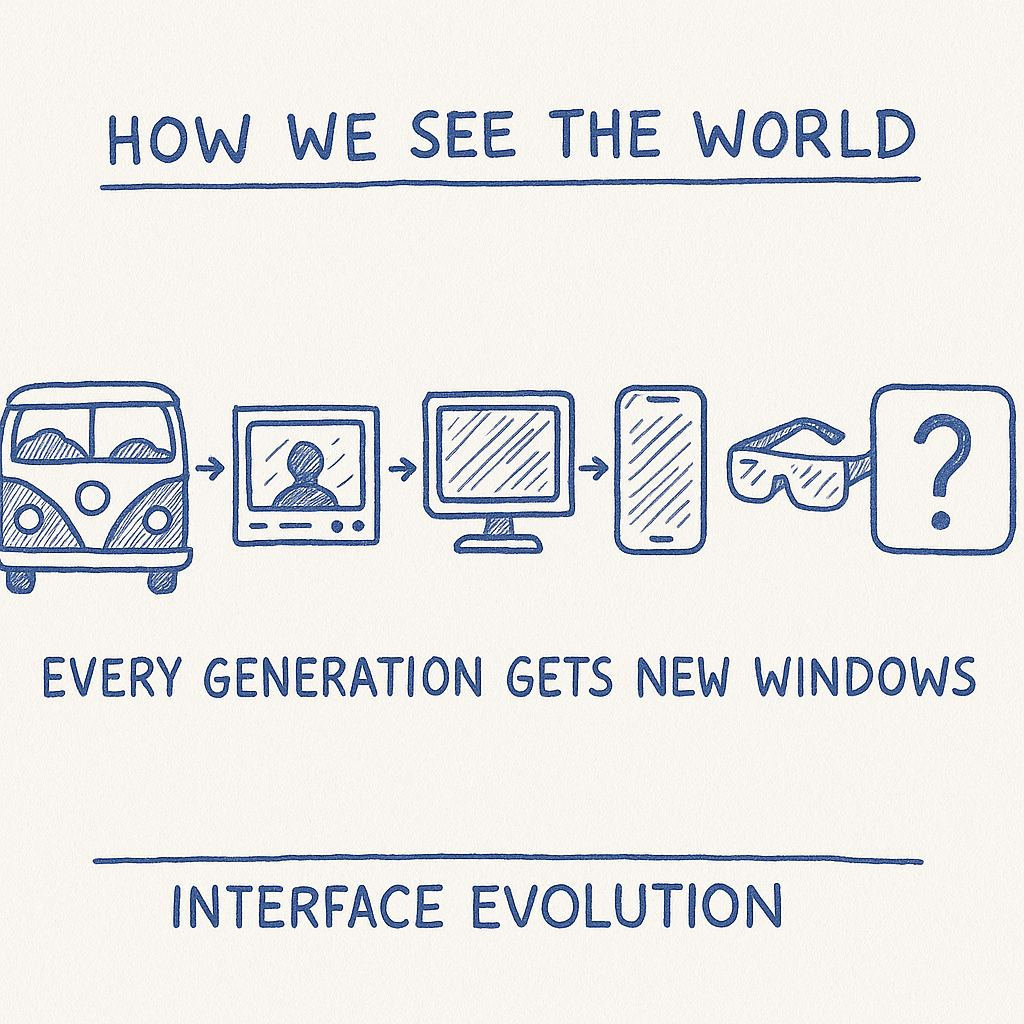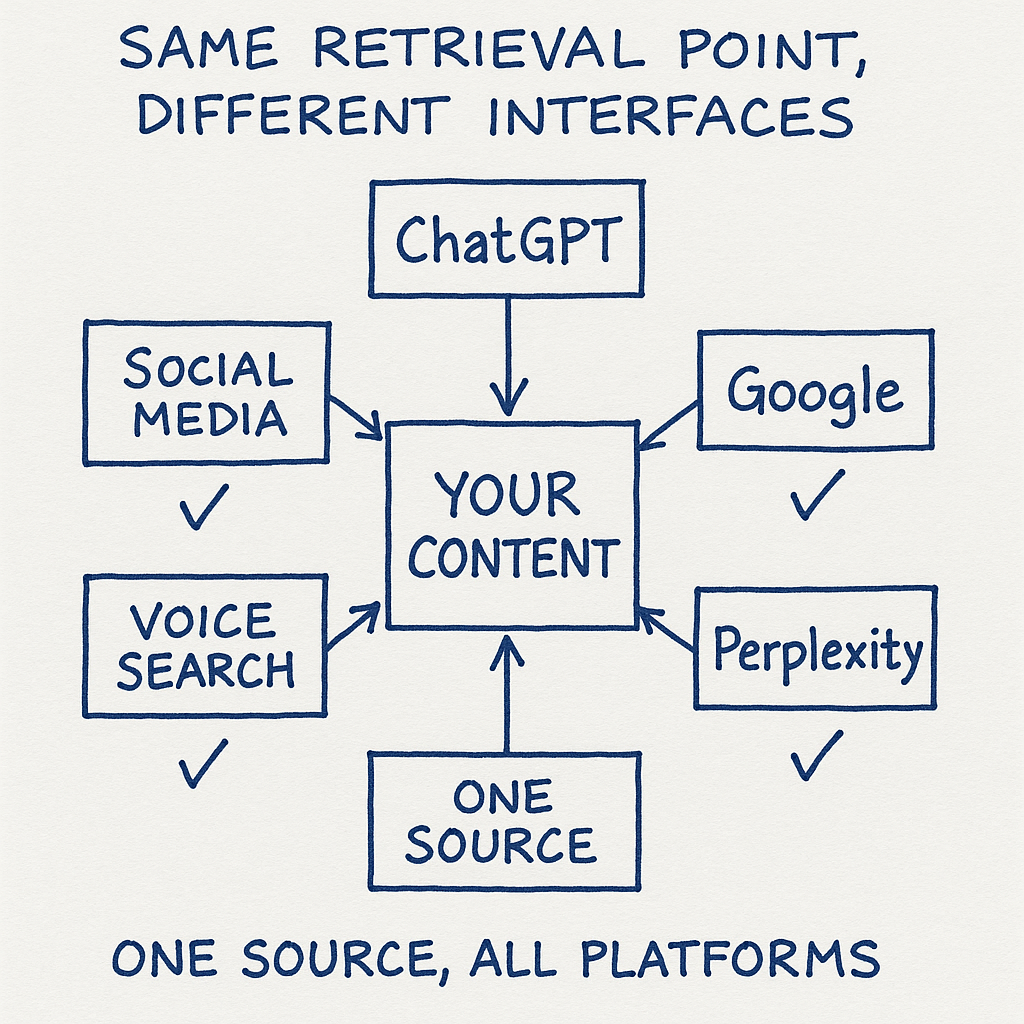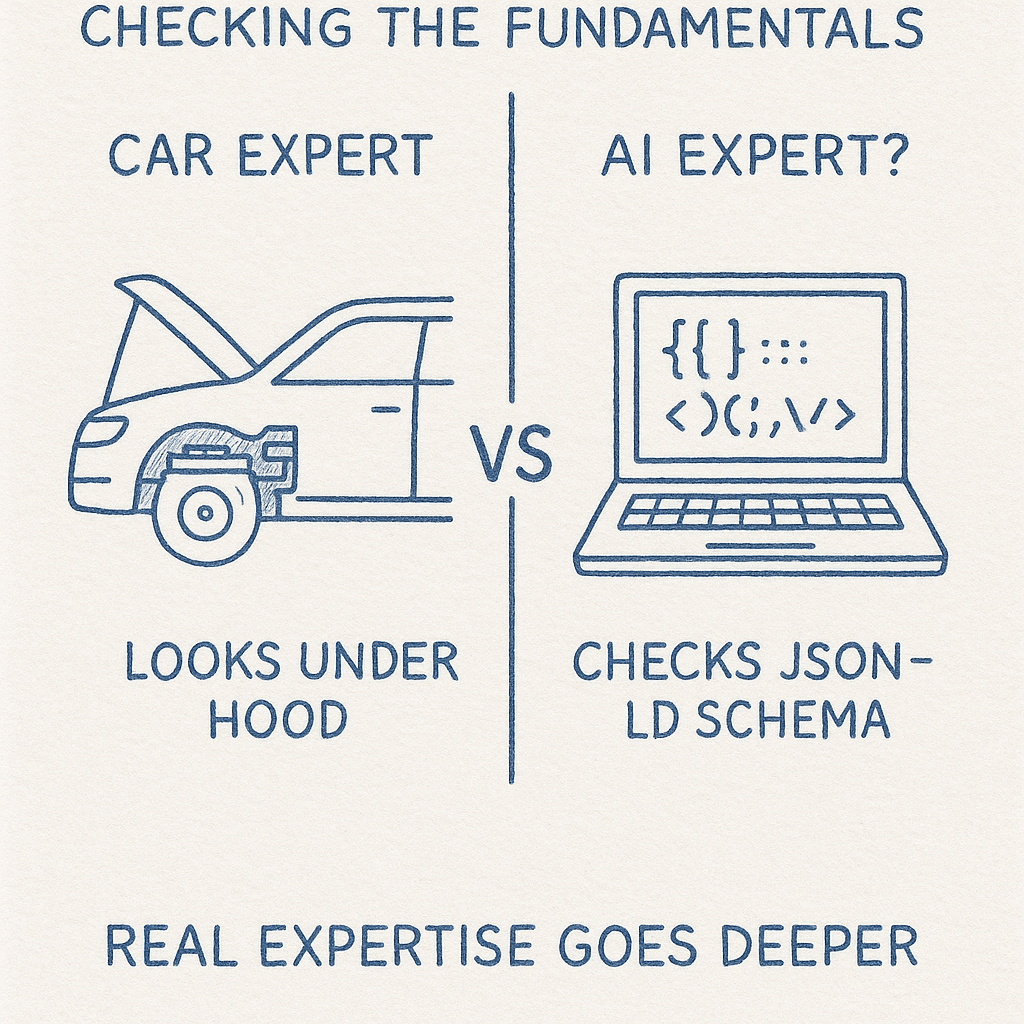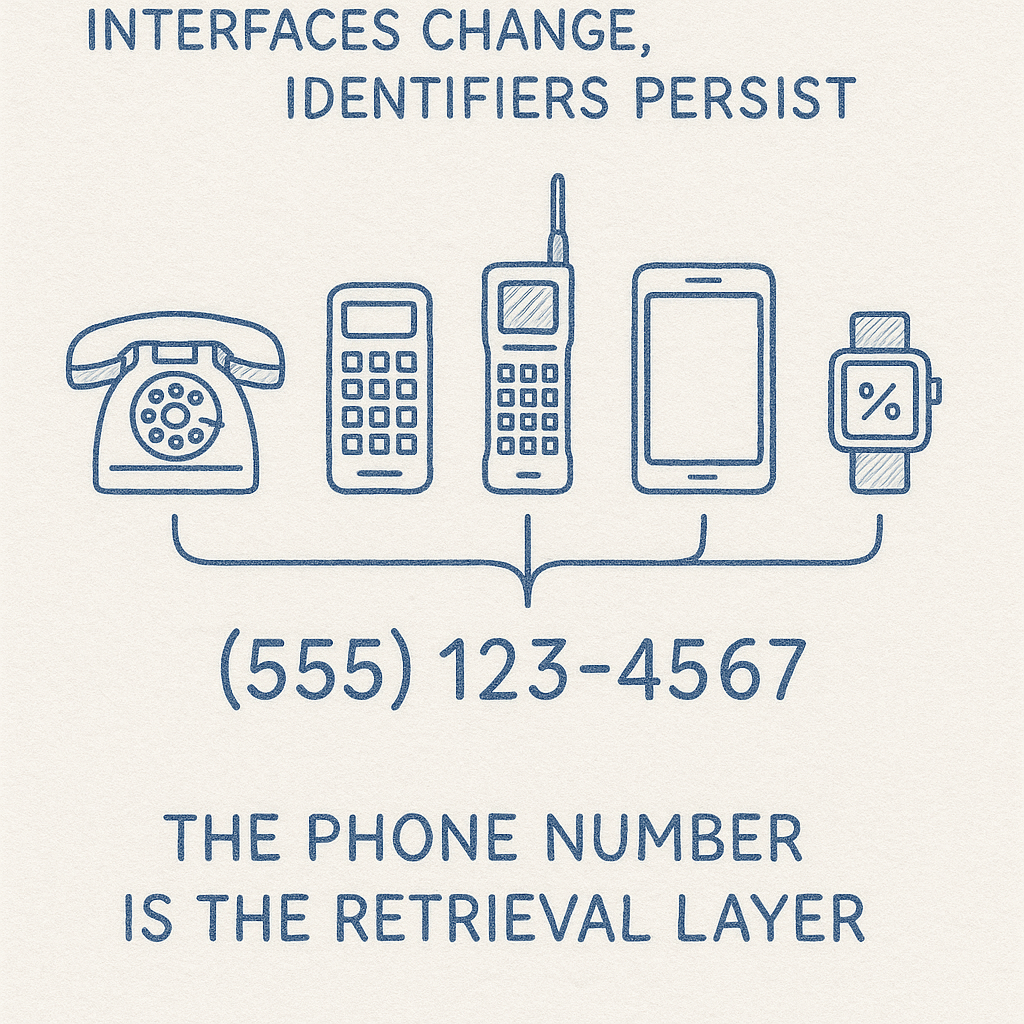The Retrieval Layer Strategy: One Optimization Approach for All AI Interfaces

Why Smart Organizations Are Shifting from SEO to Retrieval Layer Optimization
How AI Changed Search Forever
It has been a while since I have seen anyone swipe a physical debit card instead of tapping it or their phone or smart watch on a payment terminal. Apple Pay launched in 2014 and only a handful of places accepted it. Now, using an actual debit card is starting to feel like writing a check. The same thing is happening, but at a much faster pace with traditional search and how information is discovered, processed, and delivered.
62.6% of Google searches now result in zero clicks, meaning users get their answers without ever visiting a website. 200 million people use ChatGPT monthly, 153.5 million Americans are expected to use voice assistants in 2025, and smart glasses are experiencing 210% year-over-year growth. 71% of social media images are now AI-generated, and 41% of Facebook posts are likely created by artificial intelligence.
These aren't separate trends. While most organizations scramble to optimize for each new interface as it emerges, they're missing something fundamental. All these systems are drawing from the same well.
Google won so many people over as the search interface of choice. Now that dominance is fracturing. What comes next?
On Interfaces
I have hours and hours of memories of staring out large 70s era VW busses watching the rural and semi-developed landscapes of Ventura, Santa Barbara and San Luis Obispo counties scroll by like an infinite time lapse. Sometimes it would be one of the giant granite outcroppings of Yosemite that made you always look back over your shoulder to make sure the sky was still there. And summers in the Baja Peninsula where the desert met the ocean and the cardboard houses your mom's friend told you about looking nothing like they did in your imagination.
And other times it was riding down the street or on the bike path next to the beach on your off brand beach cruiser. Or discovering how the world looked through half a 40 oz next to a bonfire.
These interfaces all helped shape us and were grounded in the real world - like the 8-track player in the dash of those 70s VW buses. And now I find myself not staring out the window with John Denver playing, but trying to look into the future and see what happens when generative search and augmented reality replace the search box and the screen.

From Google Search to Everything Being Search
The Traditional Search Era (2000-2020)
For two decades, the information discovery landscape was relatively stable. Users typed queries into search engines, received a list of links, and clicked through to websites. The optimization game was clear: rank higher in search results, get more clicks, drive more traffic.
This model created an entire industry around search engine optimization, with well-understood principles: keyword research, content creation, link building, technical optimization. The interface was consistent. A search box and a list of results. The optimization strategies were correspondingly focused.
The Voice Interface Maturation (2020-2025)
Voice assistants have evolved from simple command-response systems to sophisticated AI-powered interfaces. With 8.4 billion voice assistants in use globally and 20.5% of people using voice search as their primary method, voice has become a major information discovery channel.
The accuracy improvements have been dramatic: modern voice recognition systems achieve 93.7% accuracy, making voice a viable interface for complex information retrieval. Smart speakers dominate with 44% of the voice commerce market, while wearables represent the fastest-growing segment at 26.5% CAGR.
The AI Chat Revolution (2022-Present)
The launch of ChatGPT in November 2022 changed everything. Suddenly, users could have conversational interactions with AI systems, asking complex questions and receiving comprehensive answers without ever visiting a website. Other platforms quickly followed: Google's Gemini, Anthropic's Claude, Perplexity's search-focused AI, and dozens of specialized AI assistants.
The adoption has been explosive. ChatGPT reached 200 million monthly users, while 13 million Americans already use generative AI as their preferred search engine. The shift represents more than new technology. It's a fundamental change in user behavior and expectations.
The Social Media Integration Revolution (2023-Present)
Perhaps the most significant development is the integration of AI across social media platforms. This isn't just about AI-generated content, though 71% of social media images are now AI-generated. It's about social platforms becoming part of the information retrieval infrastructure itself.
TikTok's object recognition can identify items in videos and provide shopping links. Instagram's Meta AI analyzes images for shopping integration. YouTube's content ID system processes millions of hours of video content. With 5.17 billion social media users generating content that trains AI systems, social media has become a core component of the retrieval layer.
The Augmented Reality Emergence (2024-Present)
The newest frontier in interface evolution is augmented and mixed reality. Meta's Ray-Ban glasses have captured 60% of the smart glasses market with over 1 million units sold. Apple's Vision Pro, despite its $3,499 price point, has sold approximately 500,000 units, indicating strong early adoption of spatial computing interfaces.
The AR/VR market is projected to grow from $46.6 billion in 2025 to $62.0 billion by 2029, with smart glasses specifically expected to maintain a 60%+ CAGR. These interfaces don't just change how we input information. They fundamentally alter how we receive and interact with it.
On Optimization
Remember when Metallica sued Napster? The band was fighting the interface, not understanding that music consumption had fundamentally shifted. Then Apple launched the iPod and iTunes, legitimizing digital music but through a different interface. Then Spotify created yet another interface with streaming. Each time, the music industry had to choose: fight the new interface or adapt to it.
But here's what stayed constant through all those interface wars: music was still music. Whether you were buying CDs at Tower Records, downloading MP3s from Napster, purchasing songs on iTunes, or streaming on Spotify, the underlying content and the human desire to discover and consume it remained the same. The companies that thrived were those that optimized for music discovery and delivery, not those that optimized for any single interface.
Two Approaches to AI Optimization
There's a lot of money to be made in prolonging the problem. An entire consulting industry has emerged around treating each interface as a separate optimization challenge. But the sharp companies are starting to see through it.
The Interface-Specific Approach
The conventional response to interface proliferation has been to develop specialized optimization strategies for each platform. SEO specialists for traditional search engines, AI prompt engineers for ChatGPT and similar systems, voice search consultants for Alexa and Google Assistant, AR/VR content creators for spatial computing interfaces, social media managers for platform-specific algorithms.
This approach treats each interface as a separate optimization challenge, requiring distinct expertise, tools, and strategies. Organizations end up with fragmented efforts: one team optimizing for Google search, another for ChatGPT visibility, a third for voice search, and a fourth for social media algorithms.

The Retrieval Layer Approach
An alternative strategy focuses on the underlying systems that power all these interfaces. Rather than optimizing for how information appears on each platform, this approach optimizes for how information gets retrieved, processed, and delivered by AI systems.
The insight driving this approach is that while interfaces are rapidly diversifying, the underlying retrieval systems share common principles and optimization factors. The same content characteristics that make information discoverable in traditional search also make it retrievable by AI chat systems, voice assistants, and social media algorithms.
What Is the Retrieval Layer Strategy?
The retrieval layer is the connective tissue beneath every modern interface—from Google to GPT, TikTok to Siri. It's not about where users search; it's about how the system decides what to show them.
Optimizing for the retrieval layer means structuring your content, citations, language, and data so that it's trusted, understood, and retrievable by AI—regardless of whether the interface is a search bar, a chatbot, or a pair of AR glasses.
So while most organizations scramble to optimize for each new interface separately, the smart move is focusing on this retrieval layer. An ongoing and evolving optimization effort that works across all current and future interfaces beats a dozen interface-specific strategies.

The Evidence
Research from Seer Interactive provides compelling evidence for the retrieval layer approach. Their study of generative search optimization techniques found that the same optimization methods produced consistent results across ChatGPT, Perplexity, Google's Gemini, and AI Overviews. A 40% increase in visibility across all platforms.
The optimization factors that proved effective across platforms include credible citations (5-6 relevant citations per content piece), authoritative quotes from reputable sources and industry experts, compelling statistics and raw data, improved readability with clear, flowing sentences and logical structure, simplified language using easy-to-understand terminology, and natural keyword integration that's context-driven rather than keyword-density focused.
These factors work because they align with how AI systems process and evaluate information quality, regardless of the interface through which that information is ultimately delivered.
Why This Works Across Platforms
Despite the diversity of interfaces, the underlying AI systems share similar architectures and evaluation methods. All systems use advanced natural language processing to understand context, meaning, and relevance. Citations, source credibility, and expertise indicators are universally valuable. Well-organized, clearly structured content performs better across all platforms. Systems prioritize information that can be verified through multiple sources. Content that directly addresses user needs succeeds across all interfaces.
Social Media as Retrieval Infrastructure
The integration of social media into the retrieval layer represents perhaps the most significant validation of the unified approach. Social media platforms now serve three critical functions: training data sources where posts, comments, and interactions provide training data for all major AI systems; real-time information feeds where AI systems access social platforms for current events, trends, and real-time information; and discovery interfaces where users increasingly find information through AI-powered social media algorithms.
This integration means that content optimized for traditional search and AI chat systems also performs well on social media platforms, and vice versa. The same principles that make content discoverable in one system make it discoverable across all systems.
Visual Content as Universal Retrieval Data
The evolution of visual content processing provides another validation of the retrieval layer approach. Modern AI systems achieve 95% accuracy in object recognition, processing visual content at rates up to 1,000 FPS. This means that every visual element in your content, from product images to infographic details, becomes searchable and retrievable across all platforms.
Whether someone asks ChatGPT about "red cotton shirts for casual wear," searches Google for "comfortable work shirts," or holds down on a TikTok video to identify clothing items, the same visual and textual optimization principles apply. The systems may present results differently, but they're drawing from the same underlying content analysis and retrieval processes.
Market Evidence
Traditional Search Declining, AI Interfaces Rising
Meanwhile, AI search adoption is growing exponentially. From 13 million Americans using generative AI as their preferred search engine in 2024, projections suggest this will grow to 90 million by 2027. This represents a fundamental shift in how people seek and consume information.
The Venture Capital Response
Of course, it is always best to do some research before jumping on a trending keyword or headline. Unless it is a TikTok dance, you have to strike while the iron is hot. In all other cases it would be a good idea to follow the money. Generative Engine Optimization (GEO) companies, specialists in optimizing content for AI chat systems like ChatGPT and Perplexity, are raising $20+ million funding rounds, with portfolio companies including Fortune 500 organizations like U.S. Bank, DocuSign, and Indeed. The investment community is betting that this shift is real and permanent.
The AI marketing services market itself is projected to grow from $20.44 billion in 2024 to $82.23 billion by 2030, representing a 25% CAGR. This growth is driven by organizations recognizing that their existing optimization strategies are becoming obsolete.
The "Hair on Fire" Problem
Venture capitalists describe the challenge many companies face as a "hair on fire" problem. Organizations are seeing 10% declines in search traffic from traditional sources while struggling to maintain visibility in AI-powered systems. The fragmented approach of optimizing for each interface separately is proving both expensive and ineffective.
Companies that have adopted retrieval layer optimization strategies are seeing different results. They're maintaining and improving visibility across all platforms because they're optimizing for the underlying systems that power all interfaces.
Where to Start?
The Resource Allocation Question
The panic has created a market for tools that promise to track every penny of resource allocation. The conventional approach demands separate strategies for each platform, someone higher up read about it on a blog from someone important. So one group chases Google algorithms while another dissects ChatGPT citations, and others ask Siri and Alexa the same question in five different ways.
There is a better way. The retrieval layer approach lets organizations focus on the underlying systems that power all interfaces. This creates efficiency, one optimization effort improves performance everywhere. Scalability, new interfaces do not require entirely new strategies. Consistency, brand messaging stays coherent across all touchpoints. And future-proofing your optimization work remains relevant as new interfaces emerge.
What to Expect from Future Interfaces
Emerging Interfaces
Current developments suggest several new discovery methods emerging: spatial computing through Apple's Vision Pro and Meta's Quest platforms creating new ways to interact with information in three-dimensional space, ambient intelligence where smart home devices and IoT systems become information discovery points, automotive integration where cars become mobile information and commerce platforms, wearable computing where smartwatches, fitness trackers, and augmented reality glasses create new touchpoints, and voice-first devices from smart speakers to voice-activated appliances making the future look a lot more like the cartoons and space shows we watched as children, realer than ever.
The Acceleration of AI Integration
Every new interface is being built with AI integration from the ground up. This means that optimization principles effective in current AI systems will likely apply to future interfaces as well.
The alternative, trying to optimize for each new interface as it emerges, becomes increasingly untenable as the rate of interface innovation accelerates. Organizations that focus on retrieval layer optimization will be better positioned to succeed across all current and future interfaces.
The Convergence of Digital and Physical
Perhaps the most significant trend is the convergence of digital and physical information discovery. Augmented reality interfaces allow users to point their devices at real-world objects and receive information instantly, not just shopping links, but rich contextual overlays. Point at Iolani Palace, the historical landmark in Honolulu, Hawaii, and see historical images, architectural details, stories from different eras layered over the present view.
This convergence means that optimization strategies must account for both digital content and physical presence. The retrieval layer approach addresses this by focusing on the underlying information processing systems that power both digital and physical discovery methods.
What This Might Look Like in Practice
Cross-Platform Content Performance
I was recently scrolling Facebook and saw the feed was full of AI marketing tools, agencies and services. One in particular was an agency promoting AI bots and fractional CTO engagements. Surely I could learn from them, right?
Anytime anyone or any company tells me they are an AI expert I take a look at their JSON LD schema and see how they are building out their place on the knowledge graph and trying to control how their brand and authority gets digested into the retrieval layer. This company had none. Zero structured data, no schema markup, nothing to help AI systems understand what they actually do or who they are. Yet there they were, selling AI expertise to other companies, missing the most basic and fundamental pieces required by the retrieval layer.

Even though it is early in the game, organizations that have implemented retrieval layer optimization strategies, like even the most basic JSON LD schema markup, report consistent surfacing across answer engines and search summaries. Content optimized for AI retrieval systems performs better in traditional search, AI chat systems, social media algorithms, and voice search results.
The key insight is that while the presentation of information varies across interfaces, the underlying evaluation criteria remain consistent. High-quality, well-structured, authoritative content succeeds across all platforms because it aligns with how AI systems process and evaluate information.
Successful organizations typically implement a three-phase approach: content audit phase during weeks 1-4 with comprehensive review of existing content against retrieval layer optimization factors, optimization phase during weeks 5-12 with systematic content enhancement focusing on citations, structure, and authority signals, and monitoring phase ongoing with cross-platform performance tracking and iterative improvement. Performance metrics show average improvements of 35-50% in cross-platform visibility within 90 days of implementation.
Authority Building Across Interfaces
Companies that focus on building topical authority through comprehensive, well-cited content see benefits across all discovery channels. The same content that establishes expertise in traditional search also performs well in AI chat responses, gets recommended by social media algorithms, and appears in voice search results.
This cross-platform authority building creates compounding benefits. Success in one interface reinforces authority signals that improve performance in all other interfaces, creating a positive feedback loop that becomes increasingly difficult to degrade if retrieval layer optimization and maintenance is ongoing.
Authority building requires a systematic approach: expert interview integration with 3-5 expert quotes per major content piece, citation density with a minimum 1 authoritative citation per 200 words, data integration with at least 2-3 compelling statistics per section, and cross-reference network with internal linking structure that demonstrates topic comprehensiveness. Organizations implementing this approach report noticeable improvements in how AI systems recognize their expertise.
Future-Proofing Through System-Level Optimization
Organizations that have adopted retrieval layer optimization find themselves better positioned as new interfaces emerge. When new AI-powered discovery methods launch, their content is already optimized for the underlying systems that power these interfaces.
This future-proofing aspect has proven particularly valuable given the rapid pace of interface innovation. Rather than scrambling to optimize for each new platform, these organizations can focus on maintaining and improving their retrieval layer optimization while extending their presence to new interfaces with minimal additional effort.
Future-proofing requires building content architecture that adapts to new interfaces: modular content design where content is structured in reusable components for different interface requirements, schema markup implementation with comprehensive structured data that AI systems can easily parse, multi-format asset creation where every piece of content is accompanied by visual, audio, and interactive elements, and API-ready content where content management systems are configured for easy AI system access. Organizations using this approach report 70% faster time-to-market for new interface optimization.
Implementation: Moving from Theory to Practice
Audit Your Current Optimization Efforts
I recall attending a search marketing conference in Seattle in 2008. I overheard someone say, "Bing likes my writing better and Google likes his writing better." That sounded like a lot of work to me. And those things will still happen in teams because their heads will be stuck in marketing blogs and parroting the latest experts about what's happening with the latest Google updates and making wholesale changes without looking under the hood first. Then another group will be building a secret formula because they're convinced they found a weak spot in ChatGPT's armor that will let them take their competitor out of the answer. Wholly unaware that a training data update is just two weeks away. Instead of a clear marketing plan, you've just fragmented the whole team and scattered your brand message across a dozen different approaches.
Think about how companies responded to email when fax machines were dominant. Some doubled down on fax infrastructure while others started building email systems. Where are you putting your resources - building better fax workflows or preparing for the next interface shift? If Siri or Alexa or GPT Voice can't retrieve anything about your company or product other than a bunch of co-occurring keywords, what will they say about you?
Practical Audit Framework
I have a deep love of ceramics. Used to be a TA for a ceramics professor in college and read everything I could about high-fire glazes. But you never really understand how it works until you get your hands dirty and try it yourself. It's the same principle we have applied to optimizing for the retrieval layer. We have read a ton about it, but we have also done a fair amount of real world testing and everything below stands up to current industry understanding. It is not the guide but a great checklist to make sure the basics are covered.
Content Quality Assessment Checklist:
Citation Analysis (25 points) • 5-6 credible citations per piece (15 points) • Mix of primary and secondary sources (5 points) • Recent citations within 2 years (5 points)
Authority Signals (25 points) • Expert quotes or interviews (10 points) • Industry statistics and data (10 points) • Original research or insights (5 points)
Content Structure (25 points) • Clear headings and subheadings (10 points) • Logical information flow (10 points) • Scannable format with bullet points (5 points)
Structured Data Implementation (25 points) • Basic JSON-LD schema markup (10 points) • Author and organization entities (10 points) • Content type and topic markup (5 points)
Cross-Platform Consistency (25 points) • Consistent brand messaging (10 points) • Uniform quality standards (10 points) • Coherent topical authority (5 points)
Scoring Framework: 105-125 means retrieval layer optimized, 90-104 needs moderate optimization, 65-89 requires significant improvement, below 65 needs complete optimization overhaul.
Tracking Performance
Once you've implemented changes based on the audit checklist, here are the signals to watch for across platforms to see how your retrieval layer optimization is performing.
Here are some of the leading tools for tracking these metrics across platforms. All provide comparative benchmarking capabilities (research via AEO Radar):
- Profound - Medium ease of use. Best for large-scale businesses & agencies. Platforms: ChatGPT, Perplexity, Copilot, Google AI Overviews.
- Scrunch AI - High ease of use. Best for large-scale businesses & agencies. Platforms: ChatGPT, Gemini, Perplexity, Meta, Claude.
- AthenaHQ - High ease of use. Best for mid-to-large-scale businesses & agencies. Platforms: ChatGPT, Perplexity, Gemini, Copilot, Google AI Overviews.
- Peec AI - High ease of use. Best for small-to-large-scale businesses & agencies. Platforms: ChatGPT, Perplexity, Gemini, Google AI Overviews.
- Hall - High ease of use. Best for small-to-large-scale businesses & agencies. Platforms: ChatGPT, Gemini, Perplexity, Claude, Copilot, Meta, Deepseek.
- GPTrends - High ease of use. Best for solo marketers, small businesses & agencies. Platforms: ChatGPT, Perplexity, Google AI Overviews, Gemini, Grok, Claude.
- BrandLight - High ease of use. Best for large-scale businesses & agencies. Platforms: ChatGPT, Perplexity, Gemini, Meta AI.
- Bluefish - Best for large-scale businesses & agencies. Platforms: ChatGPT, Perplexity, Gemini.
- Evertune AI - Best for large-scale businesses & agencies. Platforms: ChatGPT, Gemini, Perplexity, Claude, Meta.
- Azoma - Best for e-commerce companies of all sizes. Platforms: ChatGPT Shopping, Google AI Overviews, Amazon.
Identify Retrieval Layer Optimization Opportunities
The next step is identifying opportunities to optimize for the underlying retrieval systems rather than specific interfaces. This typically involves content quality assessment by evaluating content for the factors that AI systems universally value, accuracy, authority, structure, and relevance.
Authority signal optimization ensures content includes the citations, quotes, and expertise indicators that work across all platforms. Structural optimization organizes content in ways that AI systems can easily process and understand. Cross-platform consistency aligns messaging and quality standards across all touchpoints.
Platform-Specific Optimization Balance
While the retrieval layer approach provides the strategic foundation, certain platform-specific optimizations remain valuable when they don't conflict with the underlying strategy.
Platform-specific optimization is necessary for interface-specific format requirements like video thumbnails for YouTube, platform-unique features like TikTok's duet functionality, and audience behavior differences like LinkedIn's professional tone versus TikTok's casual style.
Resource allocation follows a decision tree: Does the platform-specific optimization conflict with retrieval layer principles? If yes, prioritize retrieval layer. Does the platform represent more than 10% of your audience? If yes, consider platform-specific investment. Can the optimization be achieved through content format adaptation rather than content change? If yes, implement. Does the platform-specific optimization require ongoing maintenance? If yes, evaluate ROI carefully.
Successful hybrid approaches include core content optimized for retrieval layer plus platform-specific formatting, universal authority signals plus platform-appropriate presentation styles, and consistent messaging plus interface-optimized delivery methods.
Measuring Cross-Platform ROI and Success Metrics
Key Performance Indicators for Retrieval Layer Optimization:
Unified Visibility Score (UVS)—a weighted average of visibility across all platforms—provides weighted average of visibility across all platforms, accounts for traffic volume and conversion value by platform, and tracks improvement over time across entire interface ecosystem.
Authority Consistency Index (ACI)—how consistently AI systems recognize your expertise—measures consistency of expert recognition across platforms, tracks citation frequency and quality across all interfaces, and indicates strength of topical authority building.
Cross-Platform Efficiency Ratio (CPER)—ROI measurement across all optimization efforts—measures ROI of optimization efforts across all platforms, compares resource investment to performance improvement, and identifies most efficient optimization activities.
Future-Readiness Score (FRS)—how prepared your content is for new interfaces—assesses content's adaptability to new interfaces, measures structured data implementation and API readiness, and tracks time-to-optimization for new platforms.
Conclusion
Look at what happened to the telephone. A humble interface that dominated for over a century, spawning payphones, pagers, entire supporting ecosystems. Then in maybe 15 years, gone. You'd be hard pressed to find a landline in anyone's home now. Even cell providers ask for your 911 service address because they assume that's where you'll actually be calling from.
The underlying human need, communication, stayed constant. But what's revealing is what survived the interface changes: phone numbers.

Whether you were using rotary phones, touch-tone, cordless, cell phones, smartphones, or smartwatches - the phone number was the retrieval layer that persisted across every interface change.
The retrieval layer will evolve. New schema types, enhanced structured data, better ways to signal authority and context. Like adding area codes to phone numbers, these improvements expand capability while maintaining compatibility. The interfaces that recognize and can parse this evolution will succeed. The ones that ignore the underlying system will become payphone manufacturers in a smartphone world.
The question isn't whether to optimize for the retrieval layer. It's whether you're building for the system that adapts and grows, or just the interface that's popular today.


Member discussion